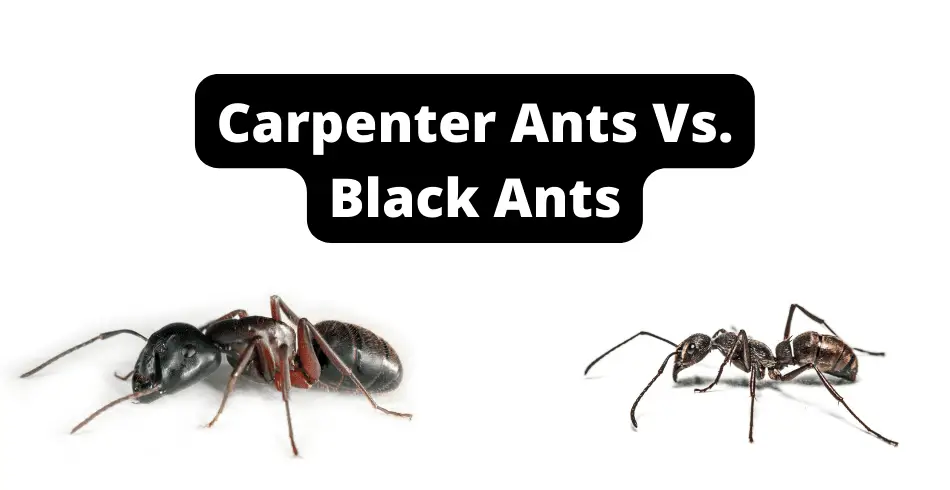While many see a black ant and immediately assume it’s a carpenter ant, that isn’t always true. Carpenter ants are sometimes confused with the common black ant (black garden ant). While both are formicine ants, only one is a cause for serious concern.
Both carpenter and black ants live on sugary foods and proteins and have a mutualistic relationship with aphids. The key difference is in size and nesting behavior. Carpenter ants are bigger and make nests inside of wood, and black ants are smaller and live in mounds.
How do I know if I have black ants or carpenter ants?
You can tell black ants from carpenter ants by assessing their size and nesting habits. Black ants are more petite than carpenter ants and have different body features. The most telling difference is habitation. Black ants live naturally in mounds, whereas carpenter ants nest in crevices inside the wood.
Here are some things you can check out;
Assess the Head shape
The difference in head and body shape is only evident under magnification (or squinting).
Use a magnifying object to review body features.
A carpenter’s ant has a heart-shaped head and a rounded thorax.
The head of a black ant has an occipital margin that is either concave, convex, or straight.
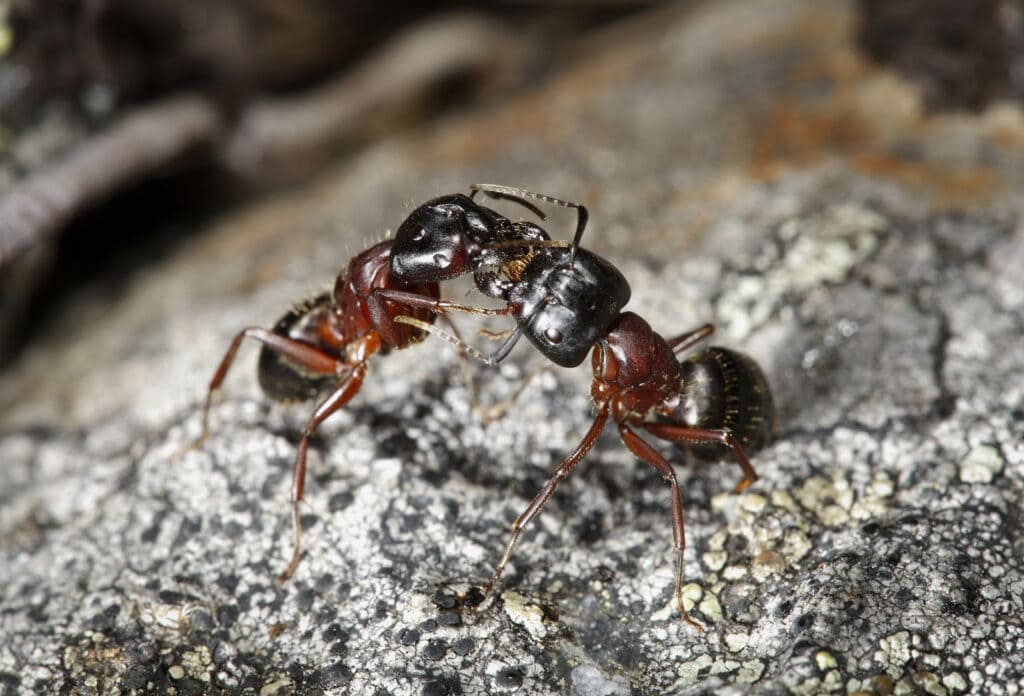
Presence or absence of wings
Male and reproductive female carpenter ants have wings; the second pair, the back wings, is smaller than the front.
Very few black ants have wings, if at all.
Noticing any winged ants or shredded wings near doors, window seals, or wooden structures could signify a carpenter’s ant problem (which you DO NOT want)
Nesting behavior
The last signal you can look for is the difference between their nests.
Black ants visit homes in search of food and water.
They live in mounds made in soils and low vegetation.
You can also find them living under stones, on sidewalks, and under the pavement.
While this isn’t what you want to see in your yard, they rarely will build inside.
When carpenter ants nest indoors, they make galleries in wood.
Look out for sawdust piles.
Listen out for slight cracking noise in timber as the carpenter ants chew away the wood.
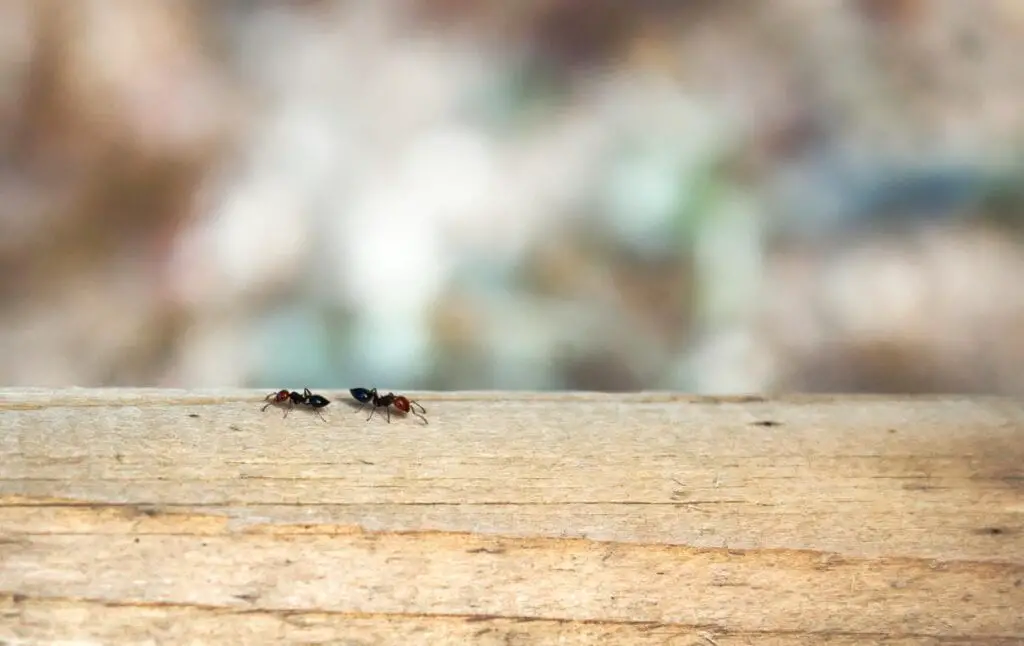
Differences Between Carpenter Ants and Black Ants
Knowing the difference between carpenter and black ants is vital in ant management and pest control. You can see differences between carpenter ants and black ants in several aspects. Noticeable variations in these two ants arise in the anatomy, habitation, colony size, nesting behavior, and reproduction characteristics.
Body size and features
Carpenter antshttps://ant-keeper.com/ants-with-stripes/ are among the largest ant types and thus are bigger than black ants.
A carpenter ant’s body length is between 0.6 to 1.2cm, and the standard black ant is between 0.5-0.7cm.
A carpenter ant has an arch-shaped or round thorax.
To see this feature, view the ant from the side.

Carpenter ant workers foraging behavior
Carpenter ants workers forage up to 300 feet away from the nest. (Source)
In contrast, black ants, following pheromone trails, explore about 98 feet away from the nest. (Source, Source)
Nest locations
Black ants make their nests in lawns, fields, gardens, and sometimes sidewalks.
However, if you see a pavement infested with ants, it’s probably from pavement ants.
Another common name (and one we heard growing up) is sugar ant.
While these ants are black, they are not formicine ants.
I wouldn’t worry much about these; they do not cause much damage.

Black garden ants are a menace on golf courses because they dig mounds in tee spaces and enjoy the sand.
Carpenter ants don’t share the same love for the golf course.
The carpenter’s ant home is burrowed deep in the wood.
It’s common to find these nests indoors and near wet wooden materials.
This spells danger for you and your house.
How do carpenter ants make their nests?
Carpenter ants nest in wood. They do this in forests and inside residential areas. They chew and burrow into the wood using their large jaws. They bore tunnels to create parent and satellite nests. The parent nest for queen ants is usually located some hundred feet from the satellite nest.
Common spots in the house where carpenter ants infest are wall cavities, eaves, floor joists, wooden window seals, and wet door frames.
To many homeowners, carpenter ants are disastrous.
Quick identification of these insects is essential for pest control.
These ants can get out of hand very quickly.
Carpenter Ants and Black Ants: Species/Genus
Carpenter and black ants are insects in the formicine family.
However, each belongs to a different genus.
Carpenter ants are in the Camponotus genus, and this genus has over 900 species.
The black ant is in the Lasius genus, which has about 115 known species.
Approximately 50 species of the Camponotus genus exist in the US and Canada. (Source, Source)
Carpenter Ants and Black Ants: Physical Appearance
A carpenter ant has a heart-shaped head, black ants have an unevenly shaped thorax, and carpenter ants have a smooth thorax.
The color of carpenter ants is blackish, brown to dark brown, and black ants are black, with some species being shiny black.
The carpenter ant is bigger than the black ant and has a slender waist.
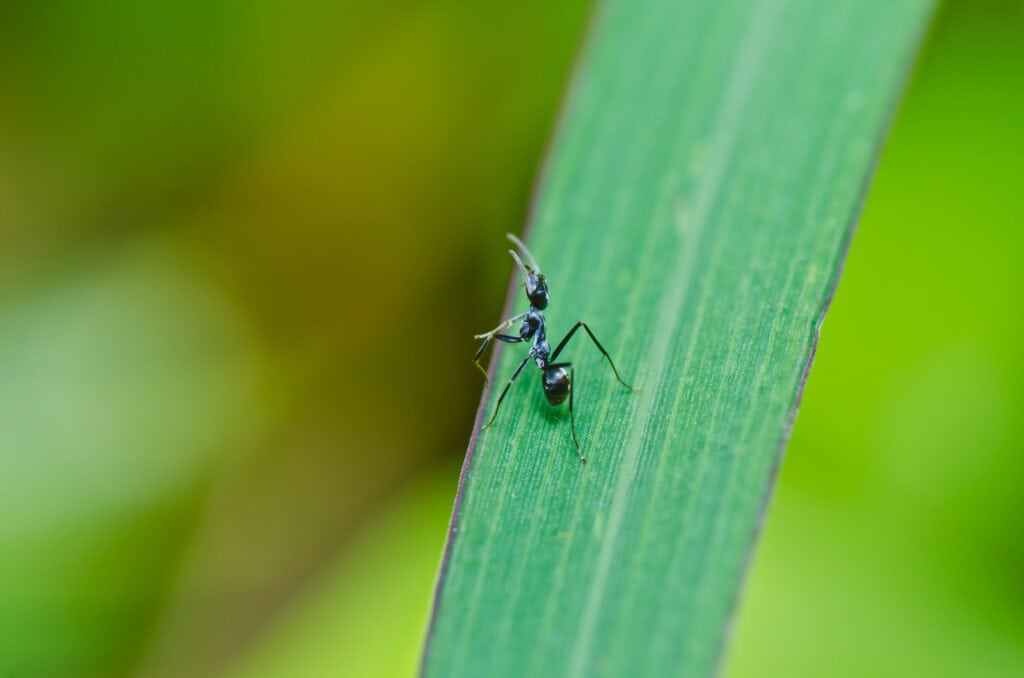
Carpenter Ants and Black Ants: Food Preferences
Both black ants and carpenter ants crave sweet sugars and proteins. Carpenter ants prefer honeydew for carbs and other insects for protein. Black ants also eat honeydew. Besides insects, they invade cheese and meat in kitchens to get proteins. Sugary foods provide energy. Proteins are for growth and development.
Worker ants in both types eat carbs for energy and feed proteins to the queen and larvae.
The difference between carpenter ants food preferences arise in how they get the carbohydrates.
Carpenter ants feed on honeydew made by conifer aphids, and black ants feed on honeydew or sugary corn sap produced by corn root aphids.
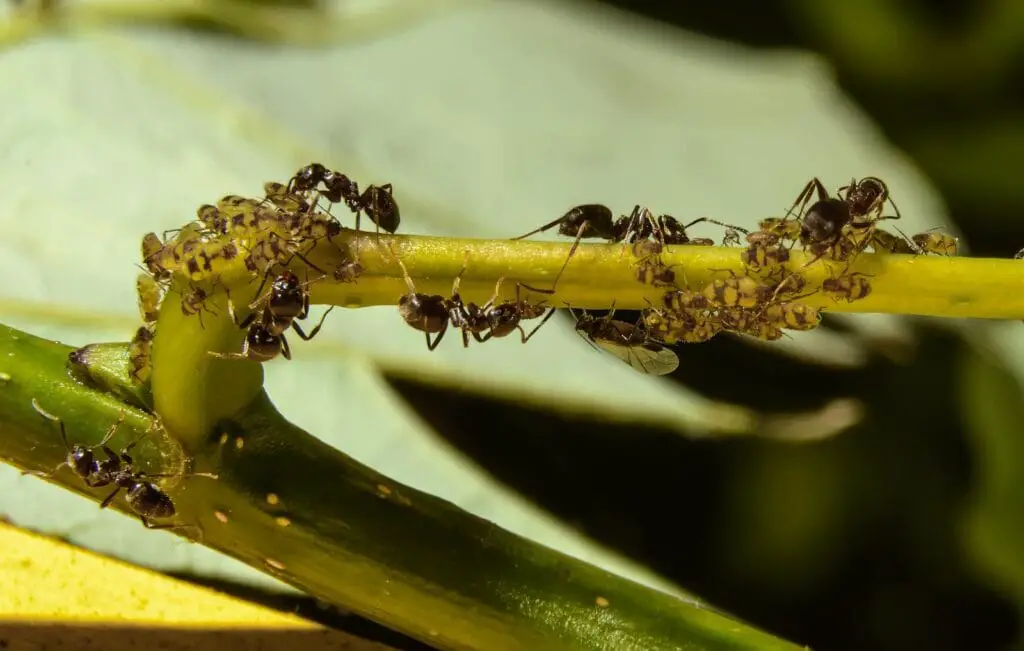
In both cases, however, the ants have a mutualistic relationship with the aphid.
They tend and protect the aphids because they help the ants meet their sugar needs by providing honeydew and carbs.
Sometimes it’s just not enough.
Black ants invade kitchens, searching for sugary food. They love to eat fruit juice and honey.
Not only that, but they crave meat.
They invade dairy and meat products for protein.
Carpenter Ants and Black Ants: General Behavior
There are some general differences between common black ants and carpenter ants. Even though they may forage in groups, carpenter ants mostly forage individually. In contrast, Black ants scavenge in groups. Carpenter ants live in nests made of wood, whereas black ants live in an underground nest dug in the soil.
When common black ants visit the house, they are after food and water.
In rare cases, black ants create nests in cracks and walls close to wet surfaces.
Carpenter ants aren’t usually after your crumbs; they’re after your wood.
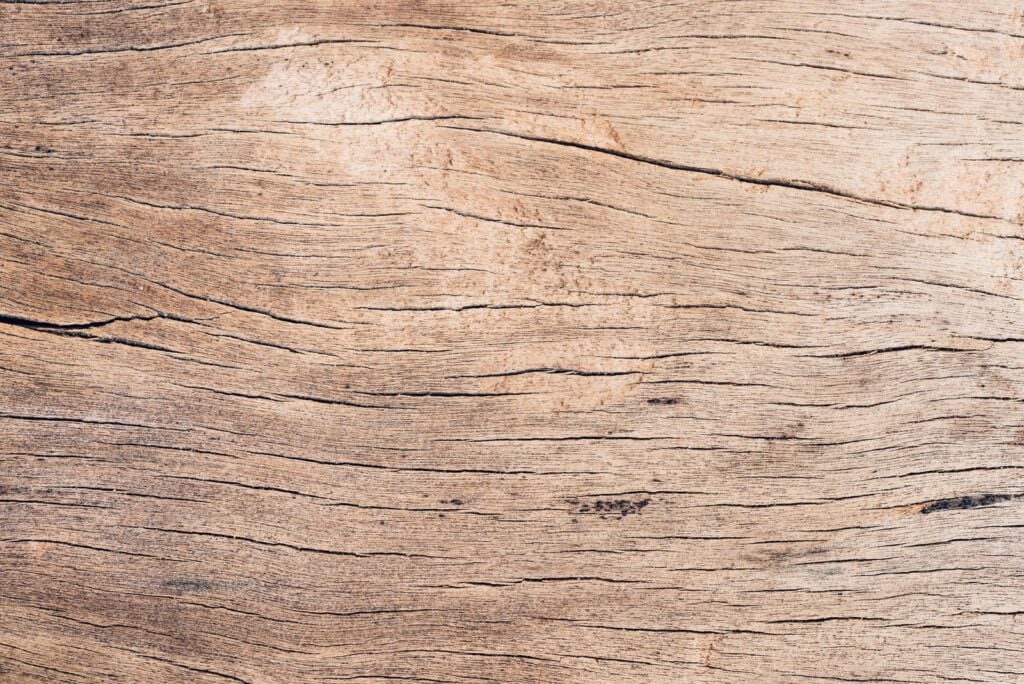
Carpenter ants will search your home for wood, making nests in damp or dead wood, walls, and other wooden materials.
Even though both types are attracted to sugary stuff, carpenter ants avoid typical ant killer baits. (Source, Source, Source)
Carpenter Ants and Black Ants: wings and nuptial flight
The females in carpenter and black ants have wings and use them to fly during the mating season when they make their nuptial flights. Most female carpenter ants have wings; among the common black ants, only the queen and males have wings.
Carpenter ants, unlike black ants, are polymorphic, and a colony has several females that can become queens.
On the other hand, Black ants are monomorphic and have a transparent caste system with distinct roles for workers, soldiers, males, and the queen.
Black ants nuptial flights in the US occur in late summer to early fall, and in Europe, they happen in summer.
The mating season occurs yearly, and the male black ant initiates the mating flights.
Carpenter Ants and Black Ants: Preferred Habitat
Black ants live in the field, whereas carpenter ants make nests in wooden structures. When black ants visit the home, they seek food or water. Carpenter ants linger around the house, searching for wooden frames to make nests.
Carpenter ants that live in nature create their nests in dead wood or trees.
The black ant digs holes in the soil to create nests.
The Black ant’s mounds are slightly raised above the grass, underneath stones, sidewalks, or pavements. (Source)
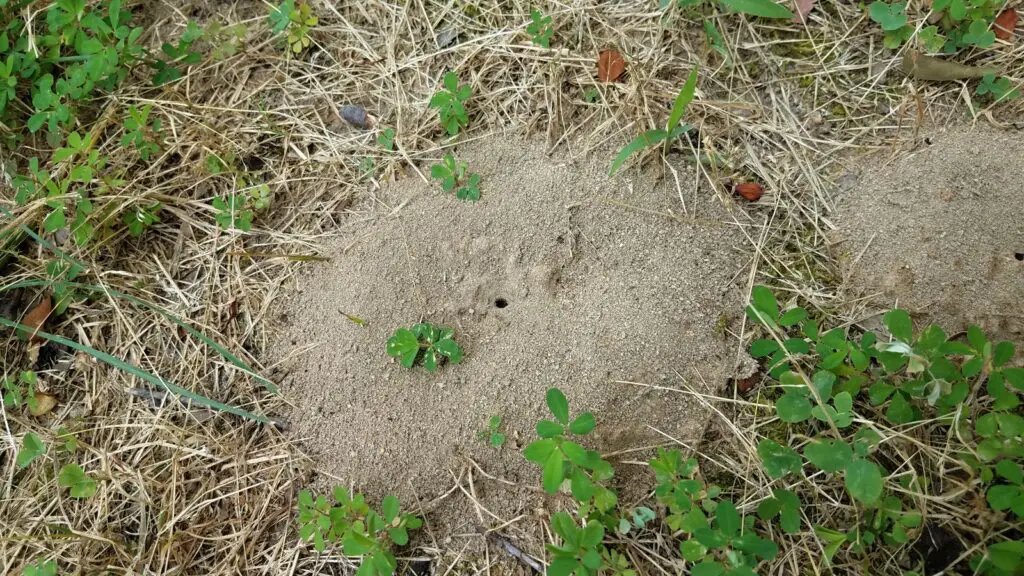
Getting Rid of Carpenter Ants and Black Ants
Carpenter ants are difficult to bait, ignoring ordinary baits that attract other ants.
In a severe carpenter ant infestation, you may have to call in the experts.
A pest control service will help and can get rid of carpenter ant infestations very quickly.
In contrast, you can bait and get rid of black ants using the most common pest control measures.
[amazon box=”B00E4GACB8″]
Getting rid of carpenter ants
The primary way to get rid of carpenter ants is to repair water leakages near wood. Also, Ensure window and door seals are airtight. Do not store damp or dead wood near the house’s perimeter, in garages, or near your water heater in the winter.
Prune tree branches and trim down shrubs that carpenter ants can use as bridges into the house.
Locate the nest by tapping the wood with an object and listening for hollowness.
You’ll have to find them.
You can also trail their convoy lines.
Once you locate the nest, drill holes at various intervals into the wood.
Pump lethal pest control chemicals into the holes.
Carpenter ants avoid regular food baits, but placed directly into the nest may yield decent results.
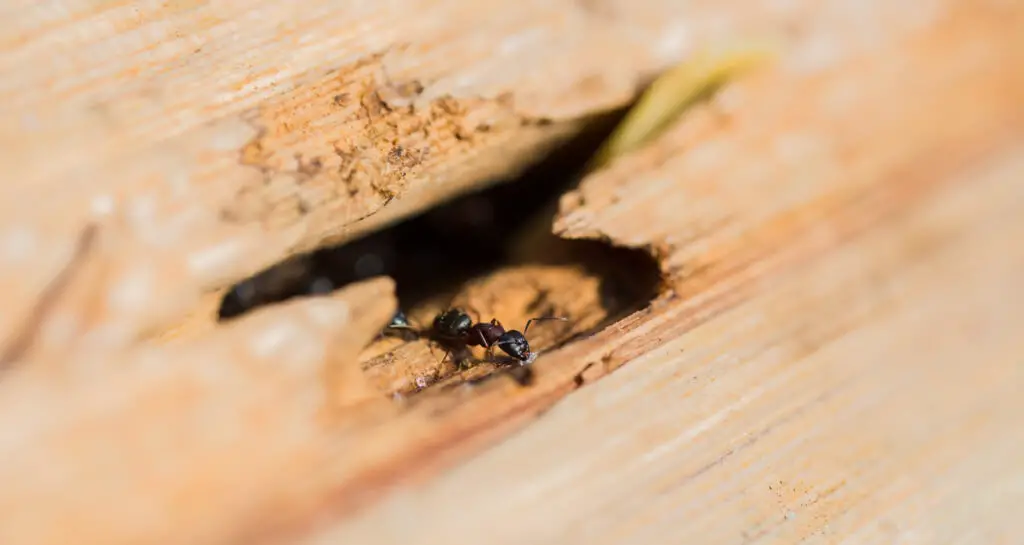
Getting rid of black ants
Black ants are easier to control.
You can apply regular ant repellents in areas where they are commonly seen.
You can bait them with chemical-laced sugary food.
For instance, adding baking soda to sugar is an effective bait.
When they consume the sugar mixed with baking soda, they die.
You can as well apply ant killer directly after locating the nest.

Should I be worried if I see one carpenter ant?
You should be concerned by the sight of one carpenter ant, as it could indicate a bigger infestation. Carpenter ants are social insects that scavenge around the nest, looking for food. The appearance of one carpenter ant is a possible indicator of a nearby nest.
Once a single carpenter ant locates a food source, it carries a tiny bit of it back to the nest.
During their long forages, the carpenter ant leaves pheromone trails for other ants leading right to the food source.
With time, you may notice other carpenter ants in your house.
Do carpenter or black ants bite?
Most ants bite or sting. Carpenter ants do not sting, and they bite using their powerful mandibles. They also inject formic acid into the target after biting. Black ants, on the other hand, bite and sting.
The carpenter ants bite is painful and itchy.
The effects are not life-threatening compared to some with stinger ant poison.
Black ants bite and sting.
But, their bite and sting are incredibly mild, and the effects are minimal because of their small stinger.
If you find any ants in the house, you probably want to find the common black ant!
Frequently Asked Questions
While we try to get to every email, sometimes it’s just easier to break it down in a frequently asked question block.
Are all black ants carpenter ants
All black ants are not carpenter ants. This is a common misconception. These ants could be sugar ants or garden ants. You need to look out for additional features. Other differentiating aspects include the size and shapes of particular body parts, such as the head and thorax.
What are big black ants called?
The typical big black ant in our living spaces are carpenter ants. They have wings, and you will find them in moist or dead wood, where they drill holes and make nests. These ants can ruin the structure of your home.
Are all carpenter ants black?
Not all carpenter ants are black. And some species are brown or dark brown, and red. Color, therefore, is not an adequate feature to identify carpenter ants, and it would be best if you look for other unique behavioral characteristics in addition to color.
What type of ants are large and black?
Large black ants in houses and sheds are carpenter ants, and they make galleries in wooden materials such as eaves, washing areas, and wet door frames. Other large ant species live freely in nature, like the bulldog ant and bullet ant.
Why am I seeing big black ants in my house?
The sight of big black ants could indicate a carpenter ant infestation. Carpenter ants attack moist wood. To be sure, catch one of them and identify it by its features. Trail it. It should lead you to their tunnels. Look for sawdust piles around the holes.
Are black carpenter ants harmful?
Black carpenter ants do not harm humans. They do bite, though, if they perceive you as an enemy. The bite effects are short-lived. Carpenter ants are destructive to wooden structures; they chew wood and make nests, leading to structural weaknesses.
